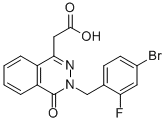| Cas No.: | 72702-95-5 |
| Chemical Name: | 3-[(4-Bromo-2-fluorophenyl)methyl]-3,4-dihydro-4-oxo-1-phthalazineacetic acid |
| SMILES: | C(CC(O)=O)1C2=C(C=CC=C2)C(=O)N(CC2=CC=C(Br)C=C2F)N=1 |
| Formula: | C17H12BrFN2O3 |
| M.Wt: | 391.2 |
| Purity: | >98% |
| Sotrage: | 2 years -20°C Powder, 2 weeks 4°C in DMSO, 6 months -80°C in DMSO |
| Description: | Statil (Ponalrestat) is an orally active, selective and noncompetitive aldose reductase (AKR1B1; ALR) inhibitor. Statil selectively inhibits ALR2 (Ki=7.7 nM) over ALR1 (Ki=60 μM). Statil inhibits the conversion of glucose to sorbitol[1][2][3]. |
| Target: | Ki: 7.7 nM (ALR2) and 60 μM (ALR1)[1] |
| In Vivo: | Statil (Ponalrestat; 10, 50 mg/kg; orally; daily; 8 weeks) reduces sorbitol accumulation indicating efficacy of aldose reductase inhibition[3]. Animal Model: Adult female Sprague-Dawley rats[3] Dosage: 10, 50 mg/kg Administration: Orally; daily; 8 weeks Result: Reduced sorbitol accumulation. |
| In Vitro: | Statil (Ponalrestat; 1, 10, 100 μM; 6 hours) reduces PGF2αproduction in response to IL-1 in both cultured endometrial cells and endometrial explants[2]. |
| References: | [1]. Ward WH, et al. Ponalrestat: a potent and specific inhibitor of aldose reductase. Biochem Pharmacol. 1990 Jan 15;39(2):337-46. [2]. Bresson E, et al. The human aldose reductase AKR1B1 qualifies as the primary prostaglandin F synthase in the endometrium. J Clin Endocrinol Metab. 2011 Jan;96(1):210-9. [3]. Calcutt NA, et al. Prevention of sensory disorders in diabetic Sprague-Dawley rats by aldose reductase inhibition or treatment with ciliary neurotrophic factor. Diabetologia. 2004 Apr;47(4):718-24. |

 DC Chemicals' products qualify for U.S. tariff exemptions. We guarantee no price increases due to customs duties and maintain stable supply, continuing to deliver reliable research solutions to our American clients.
DC Chemicals' products qualify for U.S. tariff exemptions. We guarantee no price increases due to customs duties and maintain stable supply, continuing to deliver reliable research solutions to our American clients.





















